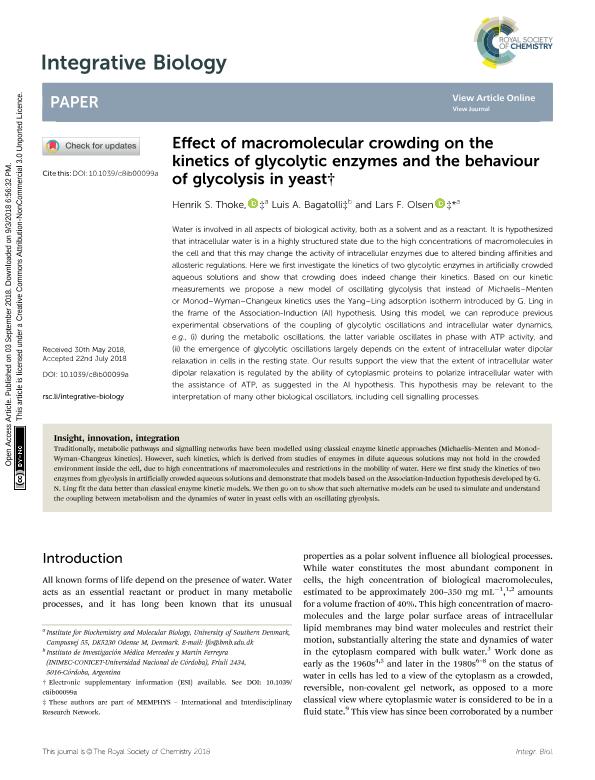Mostrar el registro sencillo del ítem
dc.contributor.author
Thoke, Henrik S.
dc.contributor.author
Bagatolli, Luis Alberto

dc.contributor.author
Olsen, Lars F.
dc.date.available
2020-02-07T18:06:54Z
dc.date.issued
2018-10
dc.identifier.citation
Thoke, Henrik S.; Bagatolli, Luis Alberto; Olsen, Lars F.; Effect of macromolecular crowding on the kinetics of glycolytic enzymes and the behaviour of glycolysis in yeast; Royal Society of Chemistry; Integrative Biology; 10; 10; 10-2018; 587-597
dc.identifier.issn
1757-9694
dc.identifier.uri
http://hdl.handle.net/11336/96877
dc.description.abstract
Water is involved in all aspects of biological activity, both as a solvent and as a reactant. It is hypothesized that intracellular water is in a highly structured state due to the high concentrations of macromolecules in the cell and that this may change the activity of intracellular enzymes due to altered binding affinities and allosteric regulations. Here we first investigate the kinetics of two glycolytic enzymes in artificially crowded aqueous solutions and show that crowding does indeed change their kinetics. Based on our kinetic measurements we propose a new model of oscillating glycolysis that instead of Michaelis-Menten or Monod-Wyman-Changeux kinetics uses the Yang-Ling adsorption isotherm introduced by G. Ling in the frame of the Association-Induction (AI) hypothesis. Using this model, we can reproduce previous experimental observations of the coupling of glycolytic oscillations and intracellular water dynamics, e.g., (i) during the metabolic oscillations, the latter variable oscillates in phase with ATP activity, and (ii) the emergence of glycolytic oscillations largely depends on the extent of intracellular water dipolar relaxation in cells in the resting state. Our results support the view that the extent of intracellular water dipolar relaxation is regulated by the ability of cytoplasmic proteins to polarize intracellular water with the assistance of ATP, as suggested in the AI hypothesis. This hypothesis may be relevant to the interpretation of many other biological oscillators, including cell signalling processes.
dc.format
application/pdf
dc.language.iso
eng
dc.publisher
Royal Society of Chemistry

dc.rights
info:eu-repo/semantics/openAccess
dc.rights.uri
https://creativecommons.org/licenses/by-nc/2.5/ar/
dc.subject
oscillating glycolisis
dc.subject
intracellular water
dc.subject
molecular crowding
dc.subject
Yang-Ling isotherm
dc.subject.classification
Biofísica

dc.subject.classification
Ciencias Biológicas

dc.subject.classification
CIENCIAS NATURALES Y EXACTAS

dc.title
Effect of macromolecular crowding on the kinetics of glycolytic enzymes and the behaviour of glycolysis in yeast
dc.type
info:eu-repo/semantics/article
dc.type
info:ar-repo/semantics/artículo
dc.type
info:eu-repo/semantics/publishedVersion
dc.date.updated
2019-10-23T14:25:44Z
dc.journal.volume
10
dc.journal.number
10
dc.journal.pagination
587-597
dc.journal.pais
Reino Unido

dc.description.fil
Fil: Thoke, Henrik S.. University Of Southern Denmark; Dinamarca
dc.description.fil
Fil: Bagatolli, Luis Alberto. Consejo Nacional de Investigaciones Científicas y Técnicas. Centro Científico Tecnológico Conicet - Córdoba. Instituto de Investigación Médica Mercedes y Martín Ferreyra. Universidad Nacional de Córdoba. Instituto de Investigación Médica Mercedes y Martín Ferreyra; Argentina
dc.description.fil
Fil: Olsen, Lars F.. University Of Southern Denmark; Dinamarca
dc.journal.title
Integrative Biology

dc.relation.alternativeid
info:eu-repo/semantics/altIdentifier/doi/http://dx.doi.org/10.1039/C8IB00099A
dc.relation.alternativeid
info:eu-repo/semantics/altIdentifier/url/https://academic.oup.com/ib/article/10/10/587/5261228
dc.relation.alternativeid
info:eu-repo/semantics/altIdentifier/url/https://pubs.rsc.org/en/content/articlelanding/2018/ib/c8ib00099a
Archivos asociados
